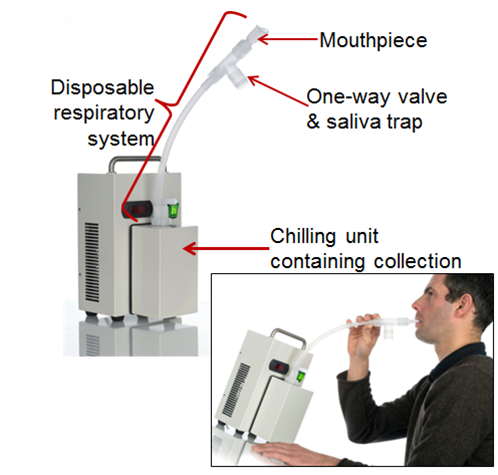Silica in Breath Research
HSE are to investigate a practical tool to assess silica
exposure. Exposure to respirable crystalline silica (RCS) can cause
silicosis and lung cancer. In GB it is estimated that 600 people
die per year from lung cancer caused by silica exposure at work.
This HSE project is to develop a new scientific approach to
determine silica containing particles in a worker's breath
sample.
What is EBC?
Exhaled breath condensate (EBC) is the collection of air that we
breathe out, cooled down into a liquid that can then be analysed.
EBC is a "clean" sample (>99% water) collected by simply
breathing into a tube. If we measure the liquid sample for silica
particles it is possible to see if particles are present.
How do we collect the sample?
Simply by breathing normally through a disposable, sterile
mouthpiece for 15 minutes.

What will we do with the sample?
We will analyse the samples for silica containing particles
(Si-particles) at HSE's laboratory in Buxton. We will report a
summary of all the results and share it with you.
Why is it important to measure exposure to silica?
The quick answer is to help reduce workplace exposures. Finding
Si-particles in a EBC sample could suggest that exposure has
occurred. Simply the more particles found the more exposure.
Will you help?
HSE scientists need to visit a range of different workplaces
where exposure to silica might occur, to collect samples from
volunteers.
What will it involve?
HSE scientists will be on site for one whole day, ideally
collecting worker samples first thing in the morning before any
work is done and then in the afternoon towards the end of the
shift.
The EBC sample takes 15 minutes to collect. We can collect
samples from four workers at a time. Collecting samples should be
within normal working hours and dutyholders should take
this into account when considering taking part in the study.
It will also be necessary to take some static air and bulk
samples to help with the understanding of the exposure.
What will the result mean?
The results will tell us if by measuring Si-particles in a
worker's breath we can better assess workplace exposure. We hope to
develop a routine screening method for silica in breath and for
this to be used to demonstrate effective control and management of
exposure.
If you would like to discuss further or be involved, please
contact Dr Jackie
Morton.
Back to the top